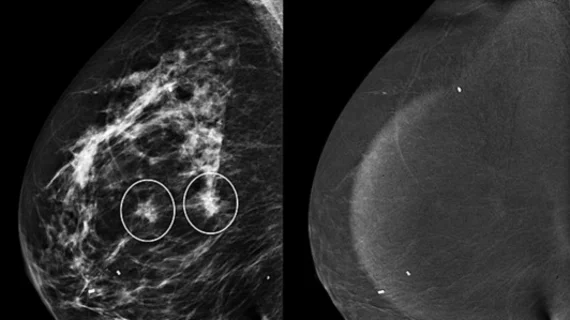Is additional imaging necessary for non-enhancing asymmetries on contrast-enhanced mammograms?
Non-enhanced asymmetries on contrast-enhanced mammography likely do not require further imaging evaluations, new research shows.
Published in the European Journal of Radiology, the new data suggest that this abnormal finding may not be cause for concern. According to the analysis, non-enhancing asymmetries (NEAs) do not appear to carry significant risk of malignancy. The findings could prevent women from having to undergo additional imaging or invasive testing, authors of the study suggested.
“Asymmetries detected on screening CEMs have been a frequent cause for patient recall. However, in diagnostic settings, a negative CEM has been proven effective in defining these asymmetries as normal or benign,” co-senior author Maxine S. Jochelson, with the Department of Radiology at Memorial Sloan Kettering Cancer Center in New York, and colleagues explained. “This raises the question of whether further diagnostic workup, such as additional mammographic views or targeted ultrasound of non-enhancing asymmetry is necessary.”
For the study, the team retrospectively reviewed just under 100 CEM exams containing NEAs. The group analyzed their type and size and compared their positive predictive value to that of enhancing asymmetries on screening CEMs.
Out of nearly 3,500 CEMs conducted over a nine-year period, just 2.8% (97) contained NEAs, with sizes ranging from 0.3 to 4.9 centimeters. They were classified as asymmetry (83), focal asymmetry (22), and global asymmetry (1), but there were no cases of developing asymmetry.
Around two-thirds of the patients underwent additional mammographic views due to the presence of NEAs, with half of those also undergoing supplemental ultrasound. One patient also completed a breast MRI. Four patients underwent breast biopsies, but none of the 97 cases of NEAs were determined to be malignant, the group noted.
“Existing data suggest that asymmetries without correlates on the recombined images are a frequent cause of patient recalls during screening,” the authors explained. “Our preliminary results support relying on the absence of enhancement on the recombined images to rule out malignancy in non-developing asymmetries detected on the low-energy images, without further diagnostic workup.”
The group indicated that their findings could help lower recall rates and contribute to improved specificity of CEM if validated by additional studies.
Learn more about the study’s findings here.

